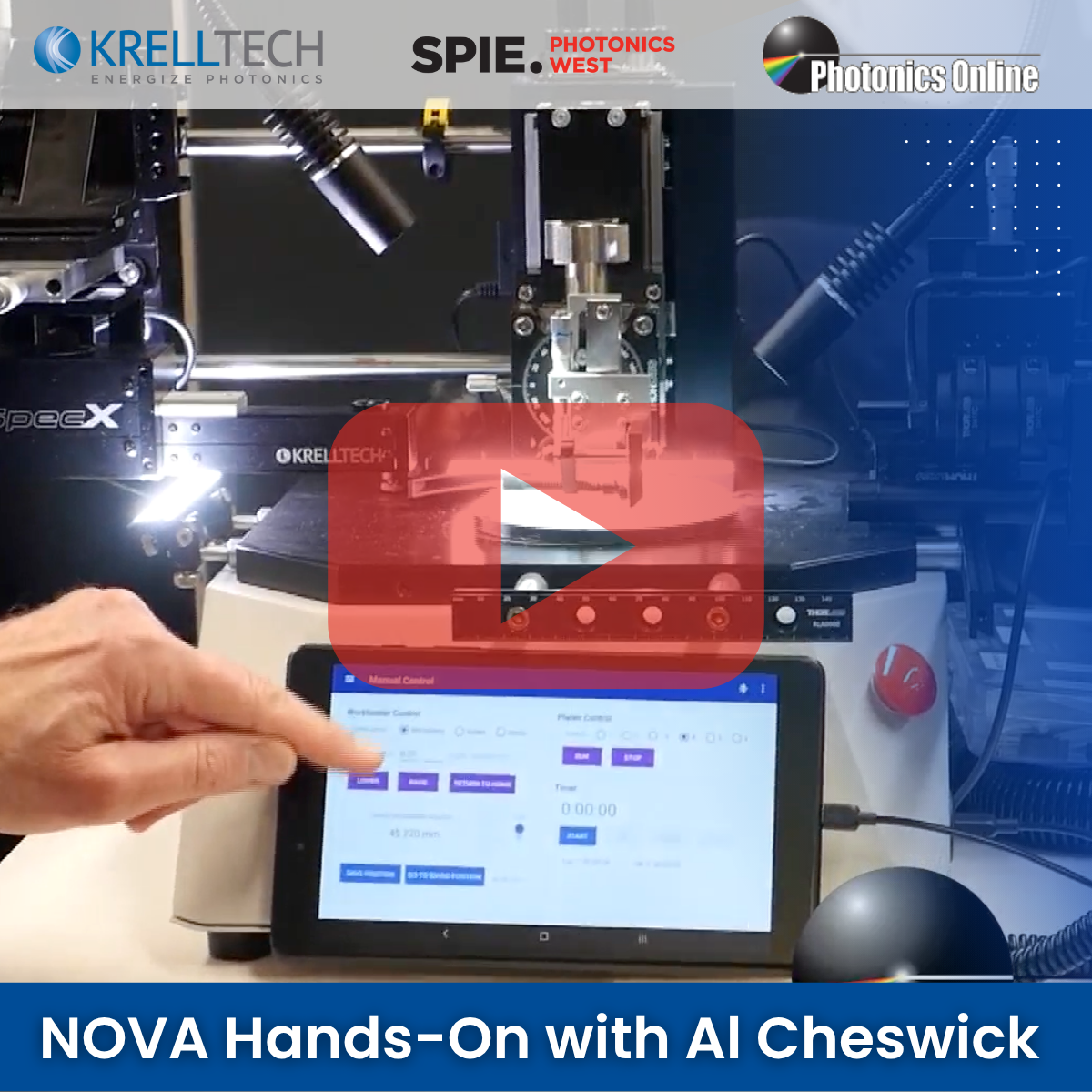NOVA™ at Photonics West: Hands-On with KrellTech’s President Al Cheswick
Release, Aug. 18, 2025, 5:08 p.m.

At this year’s SPIE Photonics West, Krell Technologies President Al Cheswick showcased a hands-on demonstration of the NOVA™ photonic polishing and inspection system—highlighting the power, precision, and flexibility behind this highly configurable platform.
Designed as a complete photonic work cell, NOVA™ integrates both polishing and in-situ inspection, offering streamlined processing for a wide range of components, including:
- Fiber connectors and aerospace terminations
- Medical probes and specialty interfaces
- Photonic Integrated Circuits (PICs) and waveguides
Al emphasized the NOVA™ system’s ability to tackle challenges unique to PIC and waveguide polishing—such as tight geometry control, consistent surface finish, and the need for adaptable fixturing during R&D phases. With micron-level control (±5µm movement), pressure distribution through independent fixture suspension, and programmable cycle options, NOVA™ delivers repeatability and results in both R&D and production settings.
“This system lets you control pressure, platen speed, and cycle timing—manually or through programmable modes—all within the same interface,” Cheswick explained.
With growing industry demand for precise and scalable PIC processing, the NOVA™ system continues to prove itself as a future-focused solution for photonics engineers and manufacturers alike.
▶️ Watch the video and explore the system in action at https://krelltech.com/videos/watch/krell-nova-system-showcase/
Full Transcript:
0:00
Hello, my name is Al Cheswick.
Hello, my name is Al Cheswick.
0:01
I'm President of Krell Technologies.
0:04
We're here at Photonics West displaying our line of photonic polishing inspection systems.
0:10
We're highlighting our NOVA system, which is a highly configurable polishing unit.
0:16
It's basically a polishing work cell because it integrates both the processing of the chip and photonic components and also the inspection of them, all while they're in the machine itself.
0:28
The system is flexible and configurable for applications ranging from standard connectors and terminize to high reliability aerospace interfaces, medical probes and devices.
0:45
And now the newer area is photonic integrated circuits and waveguides.
0:53
That's been most of our inquiries over the past year have been these type of devices and being able to process them.
1:00
There are certain challenges with processing waveguides and PICs.
1:05
These include material removal, control, surface finish and controlling the geometry of the end face.
1:13
Hence our fixturing is developed to have adjustability for different size chips because in the R&D phases which most of these chips are in now, the final dimensions are not set so you need adjustability for holding.
1:29
Additionally, you need variability on angles in order to control various things as reflectance and different types of light control.
1:40
Hence our system for material removal.
1:43
We have an interface that allows you to control all the primary parameters of polishing, which are pressure, speed and cycle timing.
1:53
These can be all adjusted in the manual mode, and basically that data that's accumulated can then be transferred to programmable modes with the same user interface.
2:05
Hence, I'm going to start the machine.
2:06
So basically we have a waveguide chip loaded in here and we can advance it.
2:13
As we're looking here on the video monitor.
2:16
This is the waveguide chip and this is the polishing surface.
2:20
We found that the tolerance for material removal is on the order of ±25 microns for most applications.
2:30
Hence the machine that you specify must have a movement of a less than that.
2:35
And our Nova has a movement of five microns.
2:38
So I'm able to step each one of these steps is five microns of movement.
2:44
Hence you can control the stock removal very accurately, which is critical for PIC processing.
2:51
Another feature is our fixtures have what we call independent suspension.
2:56
So if you're polishing multiple waveguides, each has its own freedom of movement in the Z axis.
3:02
What this provides is better pressure control and uniform distribution.
3:07
So one position is not getting more excessive pressure than an additional adjacent position and preventing any damage and provides more uniform polishing results.
3:19
So that's pretty much a summary of our equipment.
3:22
And we urge anyone that's seen this video now the stop by our booth will be here the remainder of the show on Wednesday and Thursday.